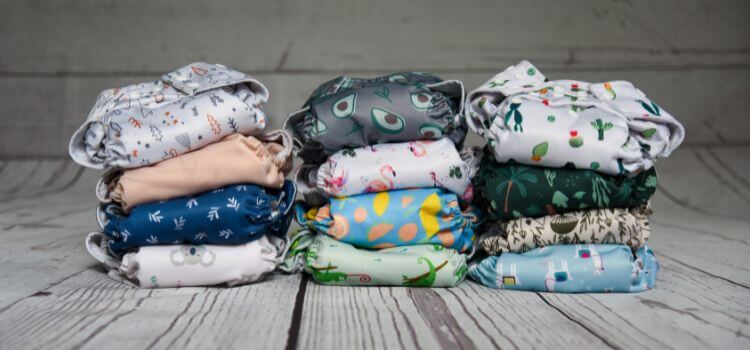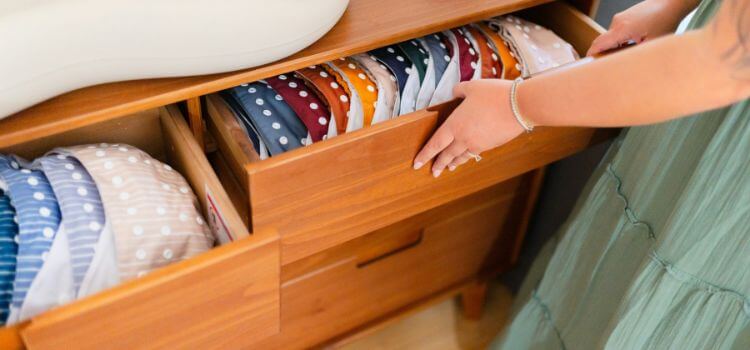As an Amazon Associate I earn from qualifying purchases.
Introduction:
With so many options on the market, you could feel confused when it comes to diapering your infant. Among these options, cloth diapers are the most environmentally friendly, economical, and kind to your baby’s sensitive skin.

Benefits of Cloth Diapers:
Comparing cloth diapers to disposable ones, there are numerous advantages. In addition to being reusable, which reduces waste and its impact on the environment, they also have a tendency to be softer and more breathable, which lowers the chance of diaper rash.
Environmental Impact:
Cloth diapers stand out as a more environmentally friendly option in the modern world, when many people are concerned about sustainability. Using cloth diapers instead of disposable ones can help your home significantly decrease its impact on landfills, as throwaway diapers can take millennia to degrade.
Understanding Newborn Diapering Needs:
Compared to older infants, newborns have different diapering demands. Determining the necessary number of cloth diapers requires an understanding of these needs.
Frequency of Diaper Changes:
Diaper changes are usually necessary for newborns, sometimes up to 10 or 12 times a day. Their immature stool production and small bladders are the cause of this high frequency.
Factors Affecting Diaper Usage:
The amount of diapers your infant will use each day depends on a variety of factors, such as eating schedule, metabolism, and personal habits.
Determining the Quantity of Cloth Diapers:
With our improved knowledge of newborn diaper requirements, let’s move on to estimating the quantity of cloth diapers you should keep on hand.
Suggested Number of Diapers per Day:
Based on the average of 10 to 12 diaper changes per day, It is advised that parents rotate at least this number of cloth diapers in their wardrobe.
Building a Stash for Newborns:
Considering the frequency of diaper changes and the time it takes for laundry cycles, it’s advisable to have a stash of at least 24 to 36 cloth diapers for a newborn.
Accounting for Washing and Drying Time:
When estimating the number of diapers you’ll need, it’s important to account for the time required for frequent washing and drying of cloth diapers. Keeping extras on hand ensures that you’ll always have a fresh diaper available for use.
Types of Cloth Diapers:
There are various types of cloth diapers available, each with its own set of features and benefits.
All-in-One Diapers
Particularly for new parents, these diapers are practical and quick to use because of the absorbent layers that are stitched into the diaper cover.
Pocket Diapers
The waterproof cover of a pocket diaper has a pocket that can hold absorbent inserts. You may change the absorbency level, giving you more personalization possibilities.
Prefold and Flat Diapers
Traditional options like prefold and flat diapers need to be folded and secured with clips or pins. Although they can be frightening at first, a lot of parents find them to be quite adaptable and absorbent.
Budget Considerations and Cost Savings
One of the significant advantages of cloth diapers is their long-term cost savings compared to disposable diapers.
Initial Investment vs. Long-term Savings
Cloth diapers may initially cost more than disposable diapers, but they save a lot of money over time, especially if you want to use them on many children.
Economical Options for New Parents
For budget-conscious parents, there are several economical options available, including purchasing second-hand diapers or opting for budget-friendly brands.
Tips for Managing Cloth Diapers:

Proper
storage and organization are essential for efficiently managing cloth diapers.
Laundering Techniques for Efficiency
Creating a consistent washing schedule will help maintain the freshness and cleanliness of your cloth diapers. To make sure that all detergent residue is gone, pretreat stains, wash on hot with a cloth diaper-safe detergent, and then wash twice.
Common Myths About Cloth Diapers
Cloth diapers have many advantages, but there are misunderstandings about them that may discourage some parents from using them.
Myth: Cloth Diapers Are Unsanitary
Modern cloth diapers are easy to clean and hygienic, despite popular assumption. Cloth diapers are equally as hygienic as disposables when laundered properly.
Myth: Cloth Diapers Are Inconvenient
Although it does take a little more work than using disposable diapers, many parents find that the advantages far outweigh the inconvenience. Cloth diapering can become natural with the correct routine in place.
Conclusion:
In conclusion, a newborn’s ideal number of cloth diapers depends on a number of parameters, including weight, age, diapering schedule, and frequency of laundry. You can make sure that have enough cloth diapers for your baby’s comfort and wellbeing by getting to know their needs and preferences. To make changing diapers easier, pick high-quality diapers that are comfortable, absorbent, and easy to use.
FAQs (Frequently Asked Questions):
Newborns typically require diaper changes every 2-3 hours or whenever they soil their diapers, which can amount to 10-12 changes per day.
It is rare that diaper rash will occur from properly cared for cloth diapers. Indeed, in comparison to disposable diapers, their permeable fabrics might lower the risk.
Aim to have at least 24-36 cloth diapers in your rotation to ensure you always have a clean diaper available, considering washing and drying times.
Yes, cloth diapers are generally considered more environmentally friendly due to their reusability and reduced contribution to landfill waste.
Yes, many parents successfully use cloth diapers overnight by selecting highly absorbent options and adding additional inserts for extra protection.
As an Amazon Associate I earn from qualifying purchases.